-
Kathmandu
-
Hotel, Lodge, Tea House and Tent
-
Feb, Mar, Apr & May
-
Private Car/Bus / Flight
-
Full board while on trekking
-
6059m
-
Trekking
-
1-8
Overview
Chulu Far East (6059m) is considered the most straightforward of the three Chulu Peaks; however the typical Chulu Far East Peak expedition includes the popular Thorang La pass to add to the overall adventure.
Chulu Far East Peak at 6059 meters is the obvious straightforward of the three Chulu peaks, though by no means easy. The Chulu Far East Expedition follows the route of the Annapurna Circuit Trekking and begins in the fertile low lands of Marshyandi Valley, at Besisahar and climbs along the river to reach the remote village of Chame. A grueling climb to the summit can be reached from Base camp, or a High Camp can be used (for maximizing the chances of summit success). There is a steep walk in snow up to the col at 5500 meters. Climbing Sherpas will fix ropes for the steeper sections.There is a small serac just below the summit ridge.The summit is fairly exposed. The summit view is similar to Chulu East Peak from where we witness the spectacular views of Annapaurna massifs (II, III and IV), Gangapurna, Glacier Dome, Dhaulagiri, Tilicho Peak and other snowy giants surrounding us. After ascending Chulu Far East, we descend down to Manang and from Manang, the trail rejoins the classic Annapurna Circuit trail leading to Yak Kharka, Letdar, Phedi and High camp before crossing the Thorang La Pass (5416m).
We then start descending toward Jomsom via Muktinath and Kagbeni. We take a morning flight from Jomsom and fly to Pokhara from Jomsom (a thirty-five minute flight) and spend the rest of the day soaking up the luxuries of Lakeside and Pokhara valley.
Best Season for Chulu Far East Climbing
The best season for Chulu Far East Peak Climbing is from March to May (Spring) and from September to November (Autumn). However, the winter is also a great time to climb if you are well prepared for the cold weather. In the crisp and cold month of December the views of the mountains are crystal clear and there are fewer tourists around. The duration of the trip can be lengthened or shortened according to your preference. Annapurna Foothills Treks and Expedition will arrange every detail of your Chulu Far East Expedition; lodge accommodation, guides, food, as well as all the necessary climbing and camping equipment.
How difficult and technical is Chulu Far East?
Chulu Far East Peak (6059m) is generally considered the easiest among the three Chulu Peaks. It is the least technical and features mostly gradual climbing, which makes it accessible to beginners as well. However, it’s important to note that peak climbing in general is physically challenging and the difficulty level can still vary based on factors like weather conditions, individual experience, route selection, and fitness levels.
While Chulu Far East may be comparatively less technical, it’s crucial for every climber to possess a good level of fitness, stamina, and the ability to acclimatize to high altitudes. Adequate training and preparation, both physically and mentally, are necessary to undertake the climb successfully and safely.
How can I communicate if there’s an emergency during Chulu Far East climbing?
For the trekking part, the tea houses will have internet facility or you need to purchase internet recharge cards. But the internet speed will be very basic. You can also purchase Nepalese SIM cards (NCEL or NTC) but their coverage will be limited.
Trip Highlights
- Pretty much Straightforward Trekking Peak in Annapurna ranges
- A perfect Climbing and Trekking Trip with the amazing Annapurna Circuit Trekking
- Experience the authentic culture of local people, their tradition and lifestyle, etc.
- Traverse through the beautiful landscape, flora, fauna, and cherish the natural diversity en route
- Accompanied by our experienced Sherpa climbing Guides and the Team throughout the entire expedition
- An excellent peak to confirm your alpine skills
- View from the Summitincludes astonishing Annapurna II, III and IV, Gangapurna, Glacier Dome, Dhaulagiri, Tilicho Peak and Manaslu






Write a Review